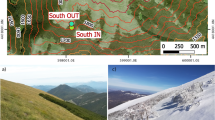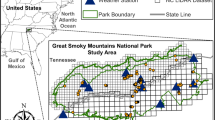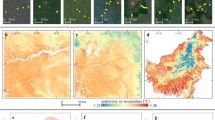Abstract
Context
Forest microclimates differ from regional macroclimates because forest canopies affect energy fluxes near the ground. However, little is known about the environmental drivers of understorey temperature heterogeneity and its effects on species assemblages, especially at landscape scales.
Objectives
We aimed to identify which temperature variables best explain the landscape-scale distribution of forest vegetation and to disentangle the effects of elevation, terrain attributes and canopy cover on understorey temperatures.
Methods
We measured growing season air temperature, canopy cover and plant community composition within 46 plots established across a 400-km2 area in Czech Republic. We linked growing season maximum, mean and minimum temperatures with elevation, canopy cover and topographic proxies for heat load, topographic position, soil moisture and cold air drainage, and created fine-scale topoclimatic maps of the region. We compared the biological relevance of in situ measured temperatures and temperatures derived from fine-scaled topoclimatic maps and global WorldClim 2 maps.
Results
Maximum temperature was the best predictor of understorey plant species composition. Landscape-scale variation in maximum temperature was jointly driven by elevation and terrain topography (\(R_{{{\text{adj}}.}}^{2}\) = 0.79) but not by canopy cover. Modelled maximum temperature derived from our topoclimatic maps explained significantly more variation in plant community composition than WorldClim 2 grids.
Conclusions
Terrain topography creates landscape-scale variation in maximum temperature, which in turn controls plant species assembly within the forest understorey. Maximum temperature is therefore an important but neglected microclimatic driver of species distribution across landscapes.



Similar content being viewed by others
References
Aalto J, Riihimäki H, Meineri E, Hylander K, Luoto M (2017) Revealing topoclimatic heterogeneity using meteorological station data. Int J Climatol 37:544–556
Anderson MJ, Ellingsen KE, McArdle BH (2006) Multivariate dispersion as a measure of beta diversity. Ecol Lett 9:683–693
Ashcroft MB, Cavanagh M, Eldridge MDB, Gollan JR (2014) Testing the ability of topoclimatic grids of extreme temperatures to explain the distribution of the endangered brush-tailed rock-wallaby (Petrogale penicillata). J Biogeogr 41:1402–1413
Ashcroft MB, Chisholm LA, French KO (2008) The effect of exposure on landscape scale soil surface temperatures and species distribution models. Landscape Ecol 23:211–225
Ashcroft MB, Chisholm LA, French KO (2009) Climate change at the landscape scale: predicting fine-grained spatial heterogeneity in warming and potential refugia for vegetation. Glob Chang Biol 15:656–667
Ashcroft MB, Gollan JR (2012) Fine-resolution (25 m) topoclimatic grids of near-surface (5 cm) extreme temperatures and humidities across various habitats in a large (200 × 300 km) and diverse region. Int J Climatol 32:2134–2148
Ashcroft MB, Gollan JR (2013) Moisture, thermal intertia, and the spatial distributions of near-surface soil and air temperatures: understanding factors that promote microrefugia. Agric For Meterol 176:77–89
Ashcroft MB, Gollan JR, Warton DI, Ramp D (2012) A novel approach to quantify and locate potential microrefugia using topoclimate, climate stability, and isolation from the matrix. Glob Chang Biol 18:1866–1879
Bedia J, Herrera S, Gutiérrez JM (2013) Dangers of using global bioclimatic datasets for ecological niche modeling. Limitations for future climate projections. Glob Planet Chang 107:1–12
Bertrand R, Lenoir J, Piedallu C, Riofrío-Dillon G, de Ruffray P, Vidal C, Pierrat J-C, Gégout J-C (2011) Changes in plant community composition lag behind climate warming in lowland forests. Nature 479:517–520
Bjornstad ON (2018) ncf: Spatial covariance functions. R package version 1.2-6. https://CRAN.R-project.org/package=ncf
Böhner J, Antonić O (2009) Land-surface parameters specific to topo-climatology. In: Hengl T, Reuter HU (eds) Geomorphometry: concepts, software, applications. Elsevier, Amsterdam, pp 195–226
Böhner J, Selige T (2006) Spatial prediction of soil attributes using terrain analysis and climate regionalisation. SAGA 115:13–28
Bramer I, Anderson BJ, Bennie J, Bladon AJ, De Frenne P, Hemming D, Hill RA, Kearney MR, Körner C, Korstjens AH, Lenoir J, Maclean IMD, Marsh CD, Morecroft MD, Ohlemüller R, Slater HD, Suggitt AJ, Zellweger F, Gillingham PK (2018) Advances in monitoring and modelling climate at ecologically relevant scales. Adv Ecol Res 58:101–161
Brice M, Cazelles K, Legendre P, Fortin M (2019) Disturbances amplify tree community responses to climate change in the temperate–boreal ecotone. Glob Ecol Biogeogr. https://doi.org/10.1111/geb.12971
Canham CD, Denslow JS, Platt WJ, Runkle JR, Spies TA, White PS (1990) Light regimes beneath closed canopies and tree-fall gaps in temperate and tropical forests. Can J For Res 20:620–631
Canty A, Ripley BD (2017) boot: Bootstrap R (S-Plus) functions. R package version 1.3-20. https://cran.r-project.org/package=boot
Chen J, Saunders SC, Crow TR, Naiman RJ, Brosofske KD, Mroz GD, Brookshire BL, Franklin JF (1999) Microclimate in forest ecosystem and landscape ecology. Bioscience 49:288
Conrad O, Bechtel B, Bock M, Dietrich H, Fischer E, Gerlitz L, Wehberg J, Wichmann V, Böhner J (2015) System for automated geoscientific analyses (SAGA) v. 2.1.4. Geosci Model Dev 8:1991–2007
Davis KT, Dobrowski SZ, Holden ZA, Higuera PE, Abatzoglou JT (2019) Microclimatic buffering in forests of the future: the role of local water balance. Ecography 42:1–11
De Frenne P, Rodriguez-Sanchez F, Coomes DA, Baeten L, Verstraeten G, Vellend M, Bernhardt-Romermann M, Brown CD, Brunet J, Cornelis J, Decocq GM, Dierschke H, Eriksson O, Gilliam FS, Hedl R, Heinken T, Hermy M, Hommel P, Jenkins MA, Kelly DL, Kirby KJ, Mitchell FJG, Naaf T, Newman M, Peterken G, Petrik P, Schultz J, Sonnier G, Van Calster H, Waller DM, Walther G-R, White PS, Woods KD, Wulf M, Graae BJ, Verheyen K (2013) Microclimate moderates plant responses to macroclimate warming. Proc Natl Acad Sci USA 110:18561–18565
De Frenne P, Zellweger F, Rodríguez-Sánchez F, Scheffers BR, Hylander K, Luoto M, Vellend M, Verheyen K, Lenoir J (2019) Global buffering of temperatures under forest canopies. Nat Ecol Evol 3(5):744
Easterling DR, Horton B, Jones PD, Peterson TC, Karl TR, Parker DE, Salinger MJ, Razuvayev V, Plummer N, Jamason P, Folland CK (1997) Maximum and minimum temperature trends for the globe. Science 277:364–367
Fick SE, Hijmans RJ (2017) WorldClim 2: new 1-km spatial resolution climate surfaces for global land areas. Int J Climatol 37:4302–4315
Fox J, Weisberg S (2011) An R companion to applied regression, 2nd edn. Sage, Thousand Oaks
Franklin J, Davis FW, Ikegami M, Syphard AD, Flint LE, Flint AL, Hannah L (2013) Modeling plant species distributions under future climates: how fine scale do climate projections need to be? Glob Chang Biol 19:473–483
Frey SJK, Hadley AS, Johnson SL, Schulze M, Jones JA, Betts MG (2016) Spatial models reveal the microclimatic buffering capacity of old-growth forests. Sci Adv 2:e1501392
Fridley JD (2009) Downscaling climate over complex terrain: high finescale (< 1000 m) spatial variation of near-ground temperatures in a montane forested landscape (Great Smoky Mountains). J Appl Meteorol Climatol 48:1033–1049
Gálhidy L, Mihók B, Hagyó A, Rajkai K, Standovár T (2005) Effects of gap size and associated changes in light and soil moisture on the understorey vegetation of a Hungarian beech forest. Plant Ecol 183:133–145
Gardner AS, Maclean IMD, Gaston KJ (2019) Climatic predictors of species distributions neglect biophysiologically meaningful variables. Divers Distrib 5:1–16. https://doi.org/10.1111/ddi.12939
Geiger R, Aron R, Todhunter P (2009) The climate near the ground, 7th edn. Rowman & Littlefield, Lanham
Gilliam F (2007) The ecological significance of the herbaceous layer in temperate forest ecosystems. Bioscience 57:845–858
Gray AN, Spies TA, Easter MJ (2002) Microclimatic and soil moisture responses to gap formation in coastal Douglas-fir forests. Can J For Res 32:332–343
Greiser C, Meineri E, Luoto M, Ehrlén J, Hylander K (2018) Monthly microclimate models in a managed boreal forest landscape. Agric For Meteorol 250–251:147–158
Grömping U (2006) Relative importance for linear regression in R: the package relaimpo. J Stat Softw 17:1–27
Guisan A, Weiss SB, Weiss AD (1999) GLM versus CCA spatial modeling of plant species distribution. Plant Ecol 143:107–122
Häntzschel J, Goldberg V, Bernhofer C (2005) GIS-based regionalisation of radiation, temperature and coupling measures in complex terrain for low mountain ranges. Meteorol Appl 12:33–42
Harwood TD, Mokany K, Paini DR (2014) Microclimate is integral to the modeling of plant responses to macroclimate. Proc Natl Acad Sci 111:1164–1165
Hofmeister J, Hošek J, Modrý M, Roleček J (2009) The influence of light and nutrient availability on herb layer species richness in oak-dominated forests in central Bohemia. Plant Ecol 205:57–75
IPCC (2014) Climate change 2014: synthesis report. Page Core Writing Team, Pachauri RK, Meyer LA (eds), Geneva
Joly D, Gillet F (2017) Interpolation of temperatures under forest cover on a regional scale in the French Jura Mountains. Int J Climatol 37:659–670
Jucker T, Hardwick SR, Both S, Elias DMO, Ewers RM, Milodowski DT, Swinfield T, Coomes DA (2018) Canopy structure and topography jointly constrain the microclimate of human-modified tropical landscapes. Glob Chang Biol 24:5243–5258
Kilibarda M, Hengl T, Heuvelink GBM, Gräler B, Pebesma E, Perčec Tadić M, Bajat B (2014) Spatio-temporal interpolation of daily temperatures for global land areas at 1 km resolution. J Geophys Res Atmos 119:2294–2313
Kopecký M, Čížková Š (2010) Using topographic wetness index in vegetation ecology: does the algorithm matter? Appl Veg Sci 13:450–459
Kopecký M, Macek M (2015) Vegetation resurvey is robust to plot location uncertainty. Divers Distrib 21:322–330
Körner C, Hiltbrunner E (2018) The 90 ways to describe plant temperature. Perspect Plant Ecol Evol Syst 30:16–21
Körner C, Paulsen J (2004) A world-wide study of high altitude treeline temperatures. J Biogeogr 31:713–732
Kovács B, Tinya F, Ódor P (2017) Stand structural drivers of microclimate in mature temperate mixed forests. Agric For Meteorol 234–235:11–21
Kulonen A, Imboden RA, Rixen C, Maier SB, Wipf S (2018) Enough space in a warmer world? Microhabitat diversity and small-scale distribution of alpine plants on mountain summits. Divers Distrib 24:252–261
Leempoel K, Parisod C, Geiser C, Daprà L, Vittoz P, Joost S (2015) Very high-resolution digital elevation models: are multi-scale derived variables ecologically relevant? Methods Ecol Evol 6:1373–1383
Legendre P, Lengendre L (2012) Numerical ecology. Elsevier, Amsterdam
Lembrechts JJ, Nijs I, Lenoir J (2018) Incorporating microclimate into species distribution models. Ecography 42(7):1–13
Lenoir J, Graae BJ, Aarrestad PA, Alsos IG, Armbruster WS, Austrheim G, Bergendorff C, Birks HJB, Bråthen KA, Brunet J, Bruun HH, Dahlberg CJ, Decocq G, Diekmann M, Dynesius M, Ejrnæs R, Grytnes JA, Hylander K, Klanderud K, Luoto M, Milbau A, Moora M, Nygaard B, Odland A, Ravolainen VT, Reinhardt S, Sandvik SM, Schei FH, Speed JDM, Tveraabak LU, Vandvik V, Velle LG, Virtanen R, Zobel M, Svenning JC (2013) Local temperatures inferred from plant communities suggest strong spatial buffering of climate warming across Northern Europe. Glob Chang Biol 19:1470–1481
Lookingbill TR, Urban DL (2003) Spatial estimation of air temperature differences for landscape-scale studies in montane environments. Agric For Meteorol 114:141–151
McArdle BH, Anderson MJ (2001) Fitting multivariate models to community data: a comment on distance-based redundancy analysis. Ecology 82:290–297
Nadeau CP, Urban MC, Bridle JR (2017) Coarse climate change projections for species living in a fine-scaled world. Glob Chang Biol 23:12–24
Økland RH (1996) Are ordination and constrained ordination alternative or complementary strategies in general ecological studies? J Veg Sci 7:289–292
Økland RH (1999) On the variation explained by ordination and constrained ordination axes. J Veg Sci 10:131–136
Oksanen J, Blanchet FG, Friendly M, Kindt R, Legendre P, McGlinn D, Minchin PR, O’Hara RB, Simpson GL, Solymos P, Stevens MHH, Szoecs E, Wagner H (2018) vegan: Community Ecology Package. R package version 2.4-6
Olaya V, Conrad O (2009) Geomorphometry in SAGA. In: Hengl T, Reuter H (eds) Geomorphometry: concepts, software, applications. Elsevier, Amsterdam, pp 293–308
Parmesan C, Root TL, Willig MR (2000) Impacts of extreme weather and climate on terrestrial biota. Bull Am Meteor Soc 81:443–450
Potter KA, Arthur Woods H, Pincebourde S (2013) Microclimatic challenges in global change biology. Glob Chang Biol 19:2932–2939
Pypker TG, Unsworth MH, Lamb B, Allwine E, Edburg S, Sulzman E, Mix AC, Bond BJ (2007) Cold air drainage in a forested valley: investigating the feasibility of monitoring ecosystem metabolism. Agric For Meteorol 145:149–166
Reger B, Kölling C, Ewald J (2011) Modelling effective thermal climate for mountain forests in the Bavarian Alps: which is the best model? J Veg Sci 22:677–687
Renaud V, Rebetez M (2009) Comparison between open-site and below-canopy climatic conditions in Switzerland during the exceptionally hot summer of 2003. Agric For Meteorol 149:873–880
Running SW, Nemani RR, Hungerford RD (1987) Extrapolation of synoptic meteorological data in mountainous terrain and its use for simulating forest evapotranspiration and photosynthesis. Can J For Res 17:472–483
Slavich E, Warton DI, Ashcroft MB, Gollan JR, Ramp D (2014) Topoclimate versus macroclimate: how does climate mapping methodology affect species distribution models and climate change projections? Divers Distrib 20:952–963
Stevens JT, Safford HD, Harrison S, Latimer AM (2015) Forest disturbance accelerates thermophilization of understory plant communities. J Ecol 103:1253–1263
Strachan S, Daly C (2017) Testing the daily PRISM air temperature model on semiarid mountain slopes. J Geophys Res Atmos 122:5697–5715
Suggitt AJ, Gillingham PK, Hill JK, Huntley B, Kunin WE, Roy DB, Thomas CD (2011) Habitat microclimates drive fine-scale variation in extreme temperatures. Oikos 120:1–8
R Core Team (2016) R: a language and environment for statistical computing. http://www.R-project.org/. R Foundation for Statistical Computing, Vienna, Austria
Tinya F, Kovács B, Prättälä A, Farkas P, Aszalós R, Ódor P (2019) Initial understory response to experimental silvicultural treatments in a temperate oak-dominated forest. Eur J Forest Res 138:65–77
Tinya F, Márialigeti S, Király I, Németh B, Ódor P (2009) The effect of light conditions on herbs, bryophytes and seedlings of temperate mixed forests in Őrség, Western Hungary. Plant Ecol 204:69–81
Tolasz R, Míková T, Valeriánová A, Voženílek V (eds) (2007) Climate atlas of Czechia, 1st edn. Czech Hydrometeorological Institute, Praha
Treml V, Banaš M (2008) The effect of exposure on alpine treeline position: a case study from the High Sudetes, Czech Republic. Arct Antarct Alp Res 40:751–760
Valladares F, Niinemets Ü (2008) Shade tolerance, a key plant feature of complex nature and consequences. Annu Rev Ecol Evol Syst 39:237–257
Valverde T, Silvertown J (1997) Canopy closure rate and forest structure. Ecology 78:1555–1562
Vanwalleghem T, Meentemeyer RK (2009) Predicting forest microclimate in heterogeneous landscapes. Ecosystems 12:1158–1172
Von Arx G, Dobbertin M, Rebetez M (2012) Spatio-temporal effects of forest canopy on understory microclimate in a long-term experiment in Switzerland. Agric For Meteorol 166–167:144–155
Von Arx G, Graf Pannatier E, Thimonier A, Rebetez M (2013) Microclimate in forests with varying leaf area index and soil moisture: potential implications for seedling establishment in a changing climate. J Ecol 101:1201–1213
Westhoff V, Van Der Maarel E (1978) The Braun-Blanquet approach. Classification of plant communities. Springer, Dordrecht, pp 287–399
Wild J, Kopecký M, Macek M, Šanda M, Jankovec J, Haase T (2019) Climate at ecologically relevant scales: a new temperature and soil moisture logger for long-term microclimate measurement. Agric For Meteorol 268:40–47
Wilson JP, Gallant JC (2000) Secondary topographic attributes. In: Wilson JP, Gallant JC (eds) Terrain analysis: principles and applications. Wiley, New York, pp 87–131
Zellweger F, Coomes D, Lenoir J, Depauw L, Maes SL, Wulf M, Kirby KJ, Brunet J, Kopecký M, Máliš F, Schmidt W, Heinrichs S, den Ouden J, Jaroszewicz B, Buyse G, Spicher F, Verheyen K, De Frenne P (2019) Seasonal drivers of understorey temperature buffering in temperate deciduous forests across Europe. Glob Ecol Biogeogr. https://doi.org/10.1111/geb.12991
Acknowledgements
We thank all our colleagues that helped us collect field data. We further thank all three reviewers and the editor for their helpful and constructive comments. This study was supported by the Czech Science Foundation (Project 17-13998S), the Grant Agency of Charles University (Project 359515) and the Czech Academy of Sciences (Project RVO 67985939).
Author information
Authors and Affiliations
Corresponding author
Additional information
Publisher's Note
Springer Nature remains neutral with regard to jurisdictional claims in published maps and institutional affiliations.
Electronic supplementary material
Below is the link to the electronic supplementary material.
Rights and permissions
About this article
Cite this article
Macek, M., Kopecký, M. & Wild, J. Maximum air temperature controlled by landscape topography affects plant species composition in temperate forests. Landscape Ecol 34, 2541–2556 (2019). https://doi.org/10.1007/s10980-019-00903-x
Received:
Accepted:
Published:
Issue Date:
DOI: https://doi.org/10.1007/s10980-019-00903-x




